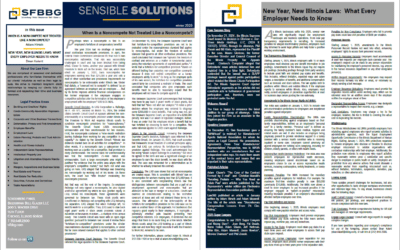Many a claim is not worth pursuing individually, and will only be brought if a potential class action lurks.
How, though, does the individual plaintiff round up enough others to form the makings of a class in actions such as under the Fair Labor Standards Act (FLSA), where potential plaintiffs are given notice and must opt in to form a class? 29 U.S.C. Section 216(b). This differs significantly from the presumptive class that lies in most other cases where members are given notice and an opportunity to opt out.
The initial step of the class certification process in FLSA cases requires plaintiffs to make only “a minimal showing that others in the potential class are similarly situated.” Jirak v. Abbott Labs., Inc., 566 F. Supp. 2d 845, 848 (N.D. Ill. 2008). The more stringent review of the similarity among plaintiffs comes only after the opt‐in process and discovery.
Soliciting enough similarly situated plaintiffs to opt in so the action can proceed on a collective basis can prove formidable. One 21st‐century approach to meeting this challenge involves soliciting potential plaintiffs via the strategic use of social media.
Take Craig Gamble, for example. This aptly named class plaintiff, together with his co‐workers at Boyd Gaming Corp., claim they were required to work overtime without pay in violation of FLSA and filed a putative federal class action in Las Vegas.
Their attorney sought out additional class members, including by creating a website and posting advertising for the putative class action on Facebook and Twitter.
The defendant complained the advertising was misleading based on advertising that asserted the plaintiffs’ attorney currently represented Boyd Gaming employees “who are owed overtime for work performed off‐theclock.” Inasmuch as liability had yet to be determined, the defendant claimed potential class members could be deceived by this language.
Showing real spunk, the plaintiff’s counsel even allegedly included a link to Boyd Gaming’s Facebook page in the subject advertising, which resulted in the ads appearing on defendant’s own Facebook news feed. Treated to a good look at them, the defendant argued these “one‐sided” ads might induce potential class members into believing Boyd Gaming had actually endorsed the messages or the plaintiffs’ claims.
The defendant therefore brought an emergency motion to enjoin Gamble’s counsel from performing any further “misleading advertising for the plaintiffs.”
The district court rejected this request in Gamble v. Boyd Gaming Corp., No. 2:13‐cv‐01009 (D. Nev. Nov. 20, 2013), but did note counsel’s duty to avoid false or misleading advertising. Evidently concluding that the subject ads were neither, the court refused to reign in the plaintiff’s aggressive social media campaign.
Rather than make findings that the ads did not mislead, however, the ruling was that “it is not the role of this court to micromanage the activities of parties or their counsel.”
The court was concerned the requested injunction “would potentially force this court to scrutinize [counsel’s] every attempt to reach out to collective action members and determine the honesty of each representation.” Clearly unwilling to assume this burden, the court rejected an emergency injunction.
Though it did not include any direct comment on the Facebook or Twitter dimensions of the plaintiffs’ communications, this unpublished decision stands as among the first to endorse, albeit rather implicitly, the use of social media to solicit potential class members.
The Federal Rules of Civil Procedure contain several newer provisions addressing modern communications technology, and electronically stored information in particular, but Rule 23’s class‐action regimen, including its notice provisions, were not updated to account for social media advances.
Very little jurisprudence or scholarly comment on the utility, effectiveness or fidelity to the equitable principles behind Rule 23 or FLSA of serving class notices via social media can be found.
Perhaps a more direct challenge to the electronic nature of the solicitation of class members by the defendants in Gamble would have engendered some analysis of how the goals of class actions under Fed.R.Civ.P. 23 or the FLSA are or are not served by permitting social media solicitations. As it was, the court apparently viewed the practice as so acceptable, and the use of social media so ubiquitous, as to require no discussion.
Interestingly, a Chicago federal court likewise took no issue with soliciting putative class members by sending them Facebook messages in another recent FLSA decision. Smith v. Family Video Movie Club, Inc., 2012 WL 4482124 (N.D. Ill.).
The Chicago court readily accepted these “informal” efforts and still required more organized notice be presented to potential class members to ensure they receive “necessary information in a clear and uniform fashion.”
Social media communications thus seem to have gained silent acceptance within the class‐action realm, notwithstanding the absence of any express support in the federal rules.
This is really not surprising in light of the prevalence and pervasiveness of social media. As author and professor of digital marketing Erik Qualman notes, “The power of social media is it forces necessary change.”



